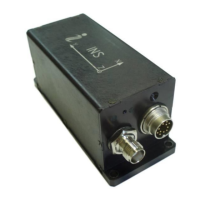INS
GUI User’s Manual
Inertial Labs, Inc
TM
Address: 39959 Catoctin Ridge Street, Paeonian Springs, VA 20129 U.S.A.
Tel: +1 (703) 880-4222, Fax: +1 (703) 935-8377 Website: www.inertiallabs.com
91
In a pull-down list in the left top corner there is an capability to choose an
orientation angle (Heading, Pitch or Roll) on which the INS will be tested.
Depending on the chosen parameter the accuracy check window name
which is shown in the Fig. 8.4 will change.
The check of the INS heading (azimuth) angle accuracy is carried out by
rotating the INS around the vertical on angles specified in the column
“Angles” Fig. 8.4.
The check of INS pitch angle accuracy is carried out by rotating the INS
around the horizontally located lateral axis X of the INS on angles specified
in the column “Angles” (see Fig. 8.4). It is necessary to note that the
accuracy control in angles 90°, 270° and close to them is not carried out
because of uncertainty of two other orientation angles – Heading and Roll in
this position.
The check of roll angle accuracy is carried out by rotating the INS around
the horizontally located longitudinal axis Y of the INS on angles specified in
the column “Angles” (see Fig. 8.4).
In the left part of check accuracy window there is a button “Devices”, by
clicking on which the window “Devices Properties” is opened (see Fig. 8.5).
In this window the operator in line “Number of Devices” sets the necessary
quantity of simultaneously tested INS units. The minimal size of parameter 1
changes on 1 by means of arrows or by keyboard necessary value input.
The size by default is 1. Then in the column “Port Name” the operator
chooses COM port number to which the INS units are connected and in a
column “Baud rate” he chooses COM-port speed which has the default value
115200 bps.
After that the operator clicks the button “Scan”. The GUI software serially
polls specified COM-ports, and in column “Device Name” names of found
INS units are displayed and button “OK” becomes active. By clicking the
button “OK” (see Fig. 8.5) names found in window “Devices Properties” are
transferred to the left of a check accuracy window (Fig. 8.4) instead of label
“NoName”. Clicking the button “Cancel” or button “X” closes the window
"Devices Properties” Fig. 8.5.
In a check accuracy window there are control buttons. The button “Angles”
opens the window “Angles Properties” Fig. 8.6, in which the operator sets
the necessary time “Accumulation Time” of data acquisition while the

